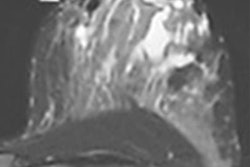
VIENNA - How well can MRI diagnose axillary lymph node metastases in patients with breast cancer? Radiologists need to interpret those results with caution in patients who received neoadjuvant chemotherapy (NAC), according to a study presented on Thursday at ECR 2019.
MRI's diagnostic accuracy was significantly better among patients who had not undergone NAC, compared with patients who had the treatment. In addition, there was better correlation between the number of abnormal nodes on MRI and on postoperative results in the non-NAC group of patients.
"Therefore, we recommend that axilla findings on MRI among patients who have undergone NAC should be interpreted with caution," said Dr. Gaurav Bansal, a consultant radiologist at University Hospital Llandough in the U.K.
Breast cancer rate
In Europe, it is estimated that one in eight women have breast cancer. For clinicians and oncologists, the condition of a woman's axillary lymph nodes is the most important factor in determining a prognosis.
Ultrasound is the primary modality of choice to assess the axilla, but its efficacy can be limited based on sonographer expertise. Ultrasound also cannot look deep or high into the axilla.
"MRI overcomes those limitations because it is operator-independent and it evaluates the full axilla," Bansal told ECR attendees. "The purpose of this study was to assess the diagnostic accuracy of MRI in two groups of patients -- patients who received neoadjuvant chemotherapy and patients who did not receive neoadjuvant chemotherapy -- and compare the MRI findings to postsurgical histology."
The retrospective study included 198 patients between 23 and 80 years of age who were diagnosed with breast cancer between 2011 and 2017. There were 112 women in the non-NAC group and 86 women in the NAC group. All of the patients underwent a baseline MRI scan before the start of NAC and again after treatment but before surgery.
The patients also underwent ultrasound imaging at the time of diagnosis. In addition, approximately 30% of patients whose lymph nodes were normal after NAC had a follow-up ultrasound to confirm the success of their treatment.
Data collection included patient age, type and grade of cancer, tumor size, and the number of abnormal lymph nodes on baseline MRI and on MRI after NAC.
Lymph node parameters
The researchers also looked at axillary lymph node parameters on MRI, which included the long-to-short-axis ratio to evaluate lymph node size, cortical thickness, and the presence of fatty hilum. Any deviation from the parameters was treated as an abnormal node.
Based on sensitivity, specificity, positive predictive value (PPV), negative predictive value (NPV), and diagnostic accuracy of the non-NAC and NAC cohorts, the researchers calculated a diagnostic odds ratio.
They discovered a statistically significant difference, with a diagnostic odds ratio of 24.6 among the non-NAC patients, compared with 7.02 in the NAC group. In other words, MRI was significantly better at detecting disease among patients who did not undergo NAC, compared with patients who received treatment.
"We also wanted to use MRI to exclude advanced disease because more patients are having conservative surgery for lower axilla," Bansal said.
In that regard, among patients with more than three positive axillary lymph nodes, MRI's NPV was statistically superior for the non-NAC group, at 99%, compared with an NPV of 83% for the NAC group (p < 0.001).
"In summary, we found there was a greater correlation between the number of abnormal nodes on MRI and on postoperative results in the non-NAC group," Bansal said. "Also, there was no statistical difference between the long-to-short-axis ratio of axillary lymph nodes between metastatic and nonmetastatic nodes."
The researchers advised that MRI should be used with caution when assessing axillary lymph nodes in patients who received neoadjuvant chemotherapy prior to surgery.



















